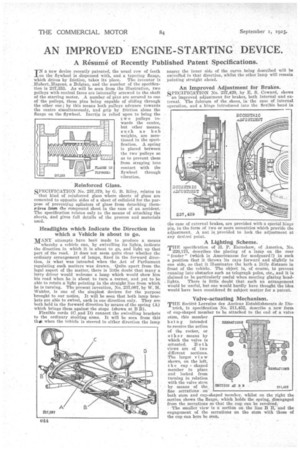AN IMPROVED ENGINE-STARTING DEVICE.
Page 28

If you've noticed an error in this article please click here to report it so we can fix it.
A Resume of Recently Published Patent Specifications.
IN a new device recently patented, the usual row of ieeth on the flywheel is dispensed with, and a tapering flange, which drives by friction, takes its place. The inventor is .Hubert.Hagens, a Belgian, and the number of the specification is 237,353. As will be seen from the illustration, two pulleys with conical faces are internally screwed to the shaft of the starting motor. A number of pins are secured to one of the pulleys, these pins being capable of sliding through the other one ; by this means both pulleys advance towards the centre simultaneously, and grip by friction alone the flange on the flywheel. Inertia is relied upon to bring the t w o pulleys towards the centre, but other means, such as bob weights, are mentioned in the specification. A spring is placed between the two pulleys so as to prevent them from straying into contact with the flywheel through
Reinforced Glass.
SPECIFICATION No. 237,379, by G. B. Riley, relates to that kind of reinforced glass where sheets of glass are cemented to opposite sides of a sheet of celluloid for the purpose of preventing splinters of glass from detaching themssIves tram the compound sheet in the case of an accident. The specification relates only to the means of attaching the shuts, and gives full details of the process and materials used.
Headlights which Indicate the Direction in which a• Vehicle is about to go.
MANY attempts have been made to produce a means
whereby a vehicle Cal), by swivelling its lights, indicate the direction in which it is about to go, and light up that part of the road. It does not seem quite clear whether the ordinary arrangement of lamps, fixed in the forward direction, is what was intended when the Act of Parliament regulating such matters was drawn. Quite apart from the legal aspect of the matter, there is little doubt that many a lorry driver would welcome a lamp which would show him his road when he is about to turn a corner, and yet to be able to retain a light pointing in the straight line from which he is turning. The present invention, No. 237,097, by W. H. Wakfer, is one of the simplest devices for the purpose brought to our notices It will be seen that both lamp brackets are able to swivel, each in one direction only. They are both held in the forward direction by means of the spring (A) which brings them against the stops (shown at B B).
Flexible cords (C and D) connect the swivelling brackets to the ordinary steering arms. It will be seen from thiS that when the vehicle is steered in either direction the lamp
nearer the inner side of the curve being described will he swivelled in that direction, whilst the other lamp will remain
pointing straight ahead. .
An Improved Adjustment for Brakes. SPECIFICATION No. 237,429, by E. S. Coward, shows an improved adjustment for brakes, both internal and external. The fulcrum of the shoes, in the ease of internal operation, and a hinge introduced into the flexible band in the case of external brakes, are provided with a special hinge p'n, in the form of two or more eccentrics which provide the adjustment. A nut is provided to lock the adjustment •at • any desired point.
• A Lighting Scheme. . THE specification of H. P. Earnshaw, of America, No. 229,175, describes the placing of a laths) on the rear " fender" (which is Aniericanese for mudguard!) in such a position that it throws its rays forward and slightly to one side, so that it illuminates the kerb a little distance in front of the vehicle. The object is, of course, to prevent running into obstacles such as telegraph poles, etc., and it is claimed to be particularly useful when meeting glaring head . lights. There is little doubt that such an arrangement would be useful, but one would hardly have thought the idea world have been considered fit subject matter for a patent.
THE SociAte Lorraine des Anciens Establishments de Die
trich, in specification No. 211,452, describe a new form of cup-shaped member to be attached to the end of a valve stern, this member being intended to receive the action of the rocker, or other means by which the valve is actuated. Both views are of two different sections. The larger view
shows, on the left, the cup shaped
member in place and lacked from turning in relation with the valve stem by means of the fine serrations on both stem and cup-shaped member, whilst on the right the section shows the flange, which holds the spring,..disengaged from the serrations SO that the cup can be reVolved. The stnallet view is a sectian on the line B .33,-and the engagement of the serrations on the stem with those of the cup can here be seen.




























